Are you as captivated by the handiwork of nature as I am? If so, you’re in for a treat. Today, we’re going to unlock the surreal world of Montana Agate, a mesmerizing time capsule sculpted in stone.
Rich in colors and patterns, it is a wondrous array of natural artistry, etched with a history as old as time. The history of the precious stone is as rich and deep as the colors it flaunts.
Their vibrant story begins with volcanic activities during the Pleistocene period, spread across millions of square miles surrounding Yellowstone Park. And guess what? This agate, intertwined with the very fabric of Big Sky Country’s sapphires, hails as Montana’s official state gemstones.
Not only is Montana Agate a stunning storyteller through its spectrum of colors, but it’s also a steadfast symbol in the discipline of metaphysical properties. Journey with me as we unveil its incredible properties, the vast lands it emerges from, and the ways it’s lovingly crafted into jewelry.
- Related article: Montana Gemstones
So let the allure of Montana Agate transport you as we are whisked off on a mesmerizing journey of color, history, and mystique. Let’s continue our exploration and unravel the various facets of Montana Agate that make it a must-see for both mineral enthusiasts and spiritual seekers.
7 Key Takeaways on Montana Agate
- Montana Agate boasts a mesmerizing blend of colors, is only found in Montana, and has distinguishing mineral compositions setting it apart from other agates.
- Formed from volcanic activity in the Yellowstone area, Montana Agate was first discovered in the late 19th century and later designated as Montana’s state gemstone in 1925.
- Montana Agate comes in a spectrum of colors achieved through a natural “recipe,” adding to its allure. The Montana Moss Agate variety is a notable option found in the Billings area.
- This chalcedony stone, with a Mohs hardness of 7, is prized for its distinct patterns and banding, making it durable and suitable for jewelry.
- Montana Agate is believed to help cleanse negative energies, balance the root chakra, and has reputed healing properties, including aiding in digestion and mental fatigue.
- The versatility of Montana Agate in jewelry, from pendants to earrings, offers a wide range of design options, and its durability makes it ideal for everyday wear.
- To ensure the longevity of your Montana Agate, gentle cleaning, proper storage away from direct sunlight and heat, and careful handling are recommended.
Things to Know About Montana Agate
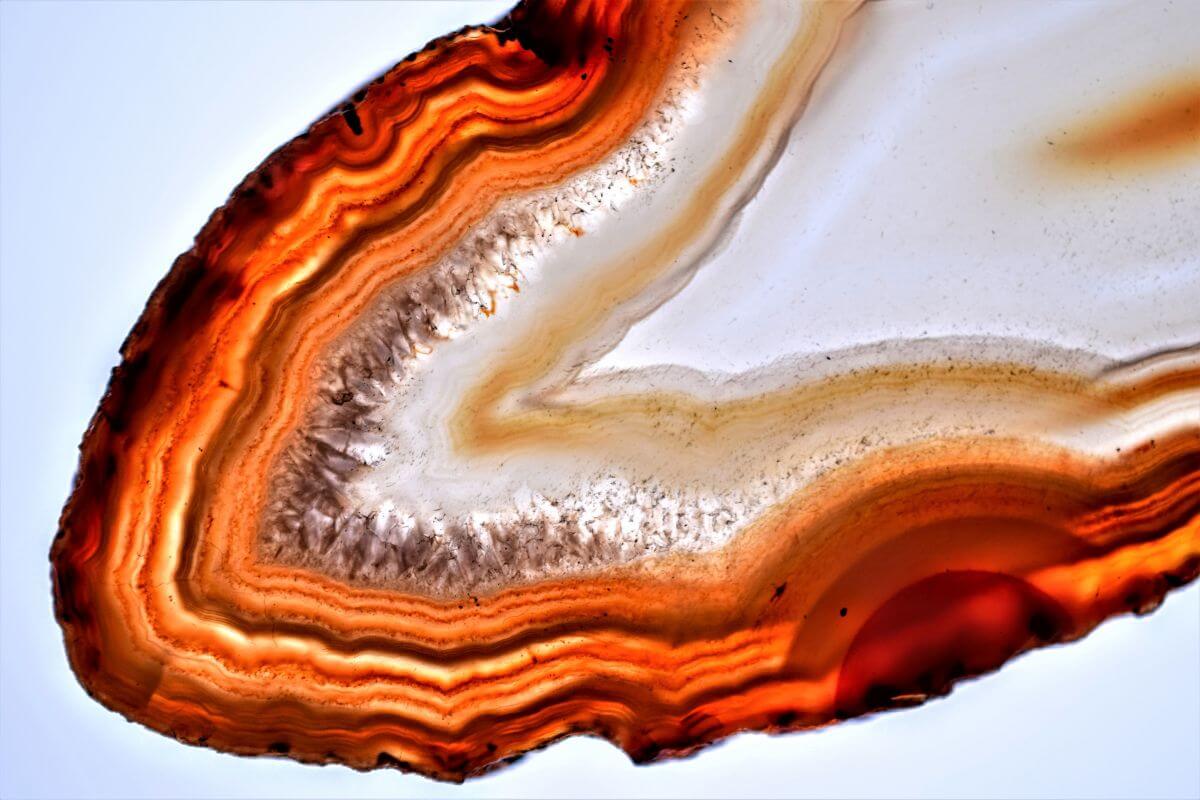
Montana Agate is a stone that has a timeless allure and a dedicated fanbase in the world of gem and rock collectors. Each slice of Montana Agate is like Mother Nature’s canvas showcasing her finest color palette.
The mesmerizing patterns, the varying transparencies, and the way it seems to tell a geological story under closer inspection — all combine to make this stone an unmissable marvel for geology enthusiasts, jewelry connoisseurs, and art lovers alike.
1. Montana Agate History
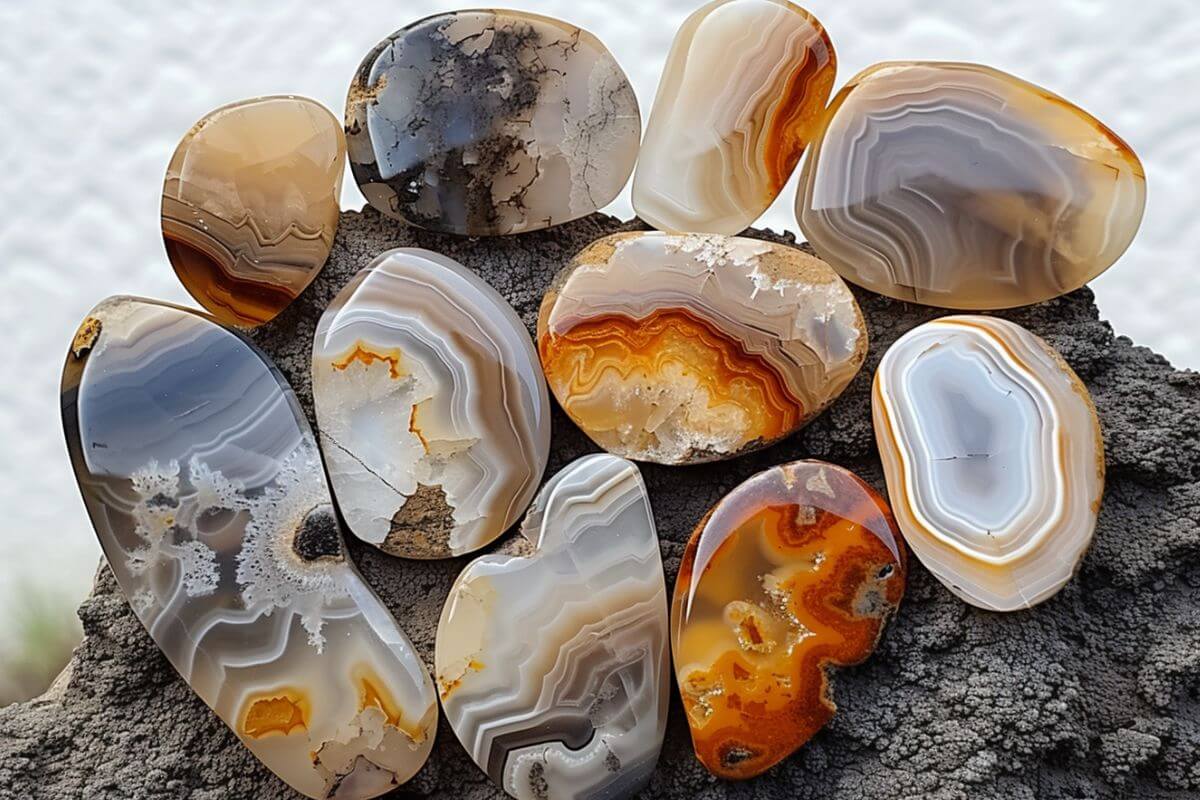
The history of Montana Agate is like a geology lesson with a dash of volcanic theater and timeless craftsmanship. It all started in the late 19th century when folks stumbling upon alluvial deposits of the Yellowstone River found a hidden treasure that could make the most flamboyant artists blush.
Back in the roaring Pleistocene period, somewhere between 2.6 million to 11,700 years ago, hot lava was playing a wild game, particularly in the areas we now call Yellowstone National Park. The volcanic acrobatics caused flows of tons of lava and incinerated thousands of acres of luscious redwoods and majestic sequoias.
But when the volcanic fireworks quieted and the rains came, mineral-laden silica water flowed into the cavities left by the dying trees and the mountains of lava, setting the stage for our star, Montana Agate, to shine.
From their original birthplace in the Yellowstone Park area, which would probably be better named Yellowstone Agate, this volcanic activity stretched across an expanse from the eastern Rocky Mountain front to Canada, encompassing hundreds of miles and millions of years.
But how does all of this volcanic action translate to our exquisite Montana Agate? Essentially, the perfect formation of agate requires a little bit of everything: silica from volcanic ash, water from ground sources, and traces of manganese, iron, and other mineral oxides playing a symphony of color.
This same color recipe would have sparked inspiration for the local natives who worked the material into their everyday use items like arrowheads. Fast forward a bit, and the art of polishing agate began in 1914, causing these stones to come into their own, strutting their stuff in jewelry and decorations worldwide.
2. Montana Agate Locations
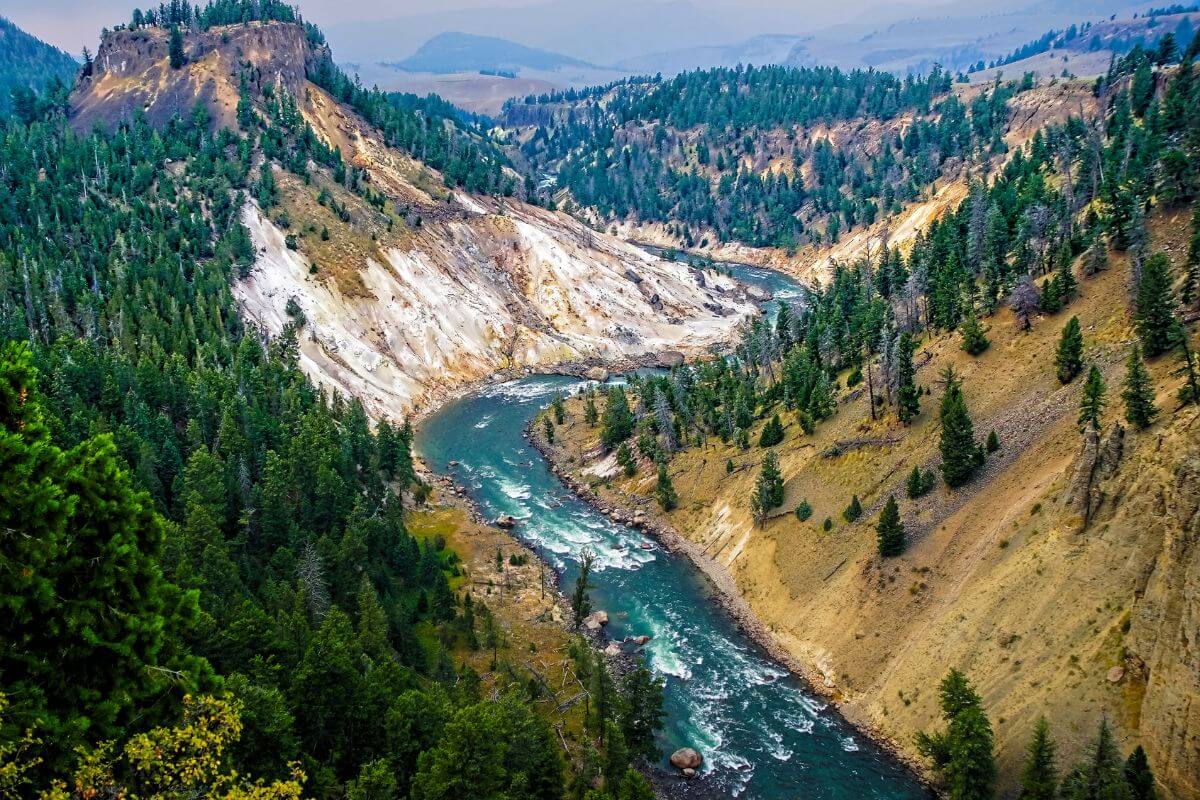
If you’re anything like me, hearing that Montana Agate can only be found in the alluvial gravel deposits of the Yellowstone River made your heart beat a little faster. Just imagine — nature’s artwork waiting to be discovered along the waters that give us the iconic Yellowstone National Park. How cool is that?
Due to its rarity and the variety of agate types available, Montana Agate hotspots have made the state a veritable playground for avid mineral collectors and have significantly heated Montana’s gem and mineral industry.
One especially noteworthy variety within this agate realm is the Montana Moss Agate, a semi-precious stone exclusively found in the Yellowstone River and its tributaries between Sidney and Billings in east-central Montana. A unique gift from the earth, if you ask me.
Now, how rare is Montana Agate? Let’s just say, it’s about as elusive as a Yeti in a crowd of penguins. The fact that it can only be extracted from the Yellowstone River’s alluvial deposits speaks volumes about its scarcity, and consequently, its value.
So, next time you’re planning a trip to Montana, why not add a rock-hounding expedition to your itinerary? Whether you’re clocking in at the primary source on the Yellowstone River, or lucky-digging around eastern Montana’s rich Montana Moss Agate territories, you’re in for an adventure unlike any other.
3. Montana Agate Colors

Nature never ceases to amaze; just when you thought Mother Earth had revealed all her colors, Montana Agate makes an entrance. From milky whites to deep reds, patriotic blues to rich browns, Montana Agate flaunts a spectrum as varied as a Pantone color chart.
The most common Montana Agate colors are white to gray, often with a tantalizing dash of almost-black or grayish-blue. Montana Moss Agate, a variety of the stone, takes it a step further by displaying moss-like, fern-like, or tree-like inclusions that could give a naturist a real run for their money.
Top colors in Montana Moss Agates include gray, white, brown, salmon, red, orange, black, and even a jaunty yellow. What’s more fascinating is how these colors are achieved — barely believable when you think that rocks hold this kind of secret recipe!
Iron oxides and hydroxides bring in those warm, autumnal hues; copper oxide is responsible for the ravishing reds and greens, while manganese oxide adds a splash of blues and browns. Just picture it: a palette handpicked by the elements, giving us this natural masterpiece.
The key to appreciating Montana Agate colors is understanding that they are not static. They depend on a confluence of factors — the angle of the crystal, the direction of the incoming light, and the delicate dance of mineral impurities within the silica. It’s almost like Montana Agates have their mood ring, but instead of feelings, they’re channeling the mineral vibes.
4. Montana Agate Physical Properties
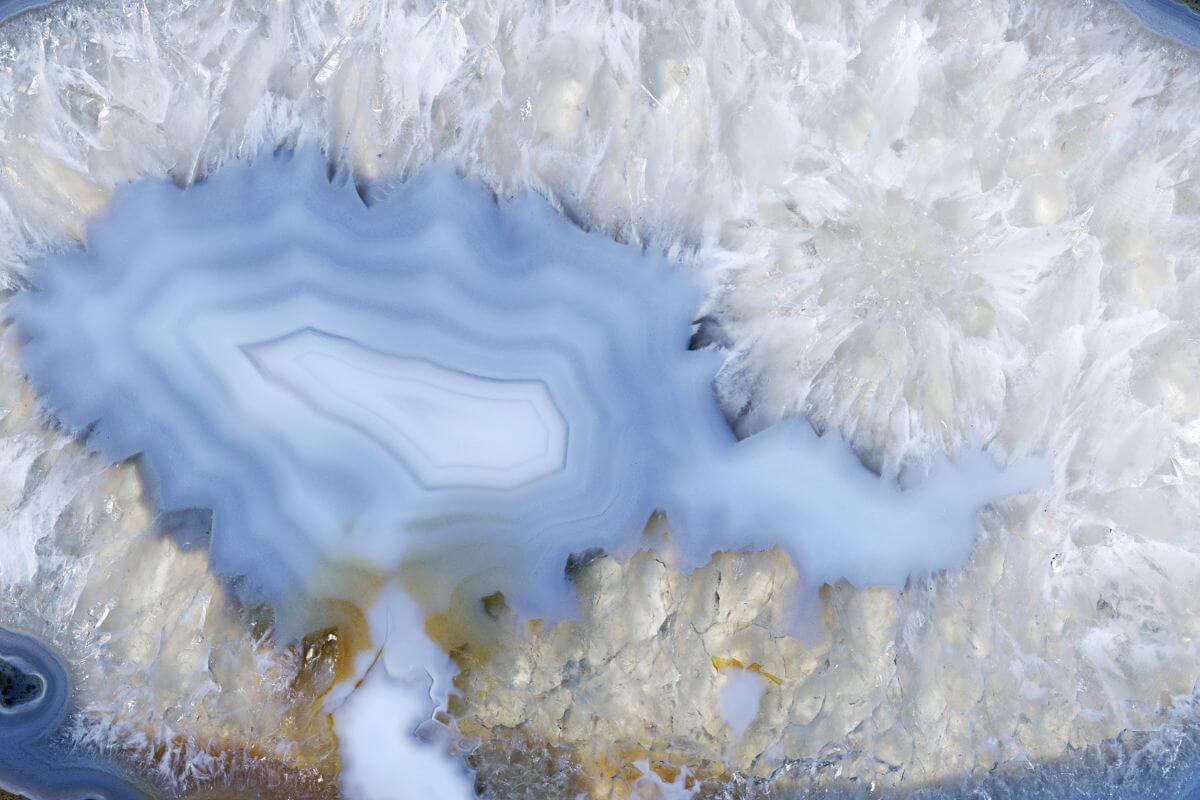
Montana Agate isn’t just another pretty rock; it’s a beautiful chalcedony that’s got substance and style. This particular beauty is a type of chalcedony, one of the many varieties of quartz renowned for its distinct banding patterns, courtesy of iron and manganese inclusions – it’s like ‘abstract art’ meets ‘nature’s canvas.’
Montana Agate usually flaunts a lustrous waxy sheen and can sometimes be that elusive combination of semitransparent and translucent. But don’t be surprised if you find a particular piece that diverges from general expectations.
Montana Agate’s color palette dances from milky white to rich browns and reds, and its Mohs Hardness of 7 means it’s no shrinking violet. You can expect the other properties listed in the table below to give you a taste of its overall constitution.
| Property | Description |
| Chemical Composition | SiO2 (silicon dioxide) |
| Class | Chalcedony |
| Cleavage | None |
| Color | Milky white to rich browns and reds |
| Fracture | Conchoidal |
| Luster | Waxy to dull |
| Mohs Hardness | 7 |
| Transparency | Translucent to opaque |
| Specific Gravity | 2.58 – 2.64 |
These characteristics aren’t just a copy-and-paste deal either. Depending on where in Montana it’s sourced, an agate can have its variations, akin to finding unique personality traits across the expanse of this vast state.
5. Montana Agate Metaphysical Properties

Montana Agate isn’t just a pretty face; it’s a stone steeped in symbolism and wellness. Wearing its kaleidoscopic hues can make you more grounded than a Zen rock garden. Practitioners believe that this sunny stone helps cleanse negative energies, in turn strengthening your stability and inner balance.
There’s an ancient metaphysical belief that this stone can relieve stress and anxiety, providing a tranquil bubble once struggled to envision. Here’s how Montana Agate is culturally thought to affect you:
- Encourages emotional balance and security by balancing the root chakra.
- Treats burns and helps with digestive issues, a little-known but practical aspect of its healing properties.
- Combats mental fatigue, enhancing focus and creativity.
- Considered a boon for Geminis in astrology, inspiring communication, and intellectual pursuits.
Beyond calming the mind, the Montana agate is also reputed to be quite the healer, catering to your body as much as your soul. It’s thought to aid in digestion, and blood circulation, and even improve conditions of the skin and eyes.
And if you thought that was all, Montana Agate tosses in some creativity and good fortune for good measure. It’s like a metaphorical Swiss army knife, right? From aiding in mental balance to stimulating creativity and boosting your connection with nature, there’s a lot this rock can do.
6. Montana Agate Jewelry
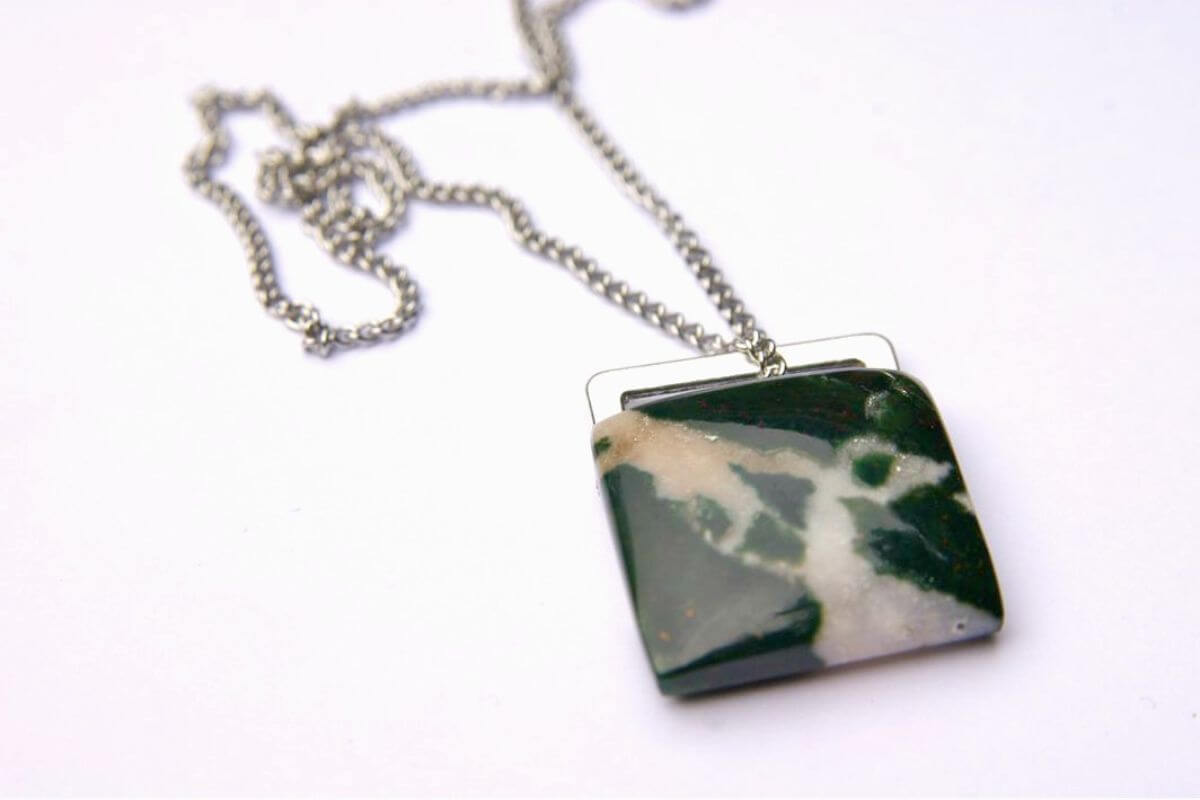
Long before Montana Agates found themselves adorning the necks and fingers of jewelry enthusiasts, they served a more utilitarian role, gracing the handles of knives and other tools. Then, as if whispering their secret allure to the world, their natural beauty landed them as a preferred choice in jewelry and decorative items.
Montana Agate, often touted for its earthy iridescence, isn’t just a stage-5 stunner; it’s also got some solid backing – a 7 on the Mohs Scale. No wonder they’ve been adopted in jewelry design and decorative sculptures with open arms.
A list of Montana Agate jewelry and other uses:
- Montana Agate Pendants – Perfect for carrying a piece of Montana’s rich landscapes and breathtaking sunsets close to your heart.
- Montana Agate Necklaces – Striking a balance between bold and understated, depending on design.
- Montana Agate Bracelets – Your daily dose of Montana brilliance, zinging your outfit.
- Montana Agate Rings – From chunky statement pieces to delicate bands, varied and versatile.
- Montana Agate Earrings – Subtle whispers or dramatic affirmations — it’s all in the design.
- Home Decor – Montana Agate pieces are also widely used in decorative sculptures and elements to infuse a touch of nature indoors.
The inherent patterns in this agate not only make each piece unique, but also complement a variety of other gemstones. I’ve rocked Montana Agate pendants paired with turquoise or jasper, and let’s just say they were gasp-worthy combinations.
Wearing your Montana Agate gemstone in concert with other stones isn’t just a how-to guide; it’s an art form in itself.
7. Montana Agate Care Tips
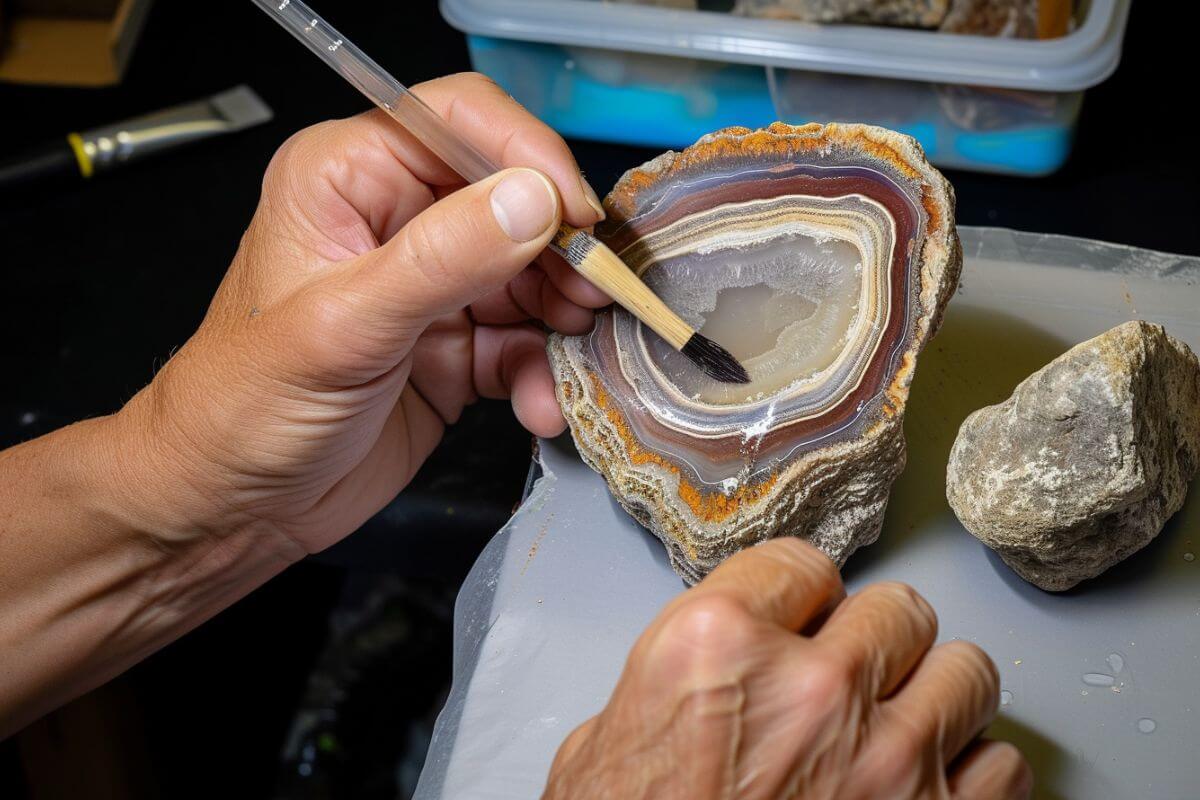
To make your Montana Agate last a proverbial lifetime, caring for it is a walk in the park. I was once told that the secrets of gemstones’ longevity are often, amusingly, simpler than you might expect.
Here’s how to take care of your Montana Agate:
- Clean the Agate – Submerge the agate in warm water and lightly suds it up with mild soap. Then rinse, and let it dry completely. Think of this as a spa day for your agate! But hold off on the mud mask; this rock can’t handle harsh chemicals or abrasives.
- Store Them Right – Treat your agate like a celebrity. Store it in a dry, cool place away from direct sunlight and extreme heat. Exposure to harsh conditions might not just affect the agate’s colors but also its geological structure.
- Handle with Care – While Montana agates are robust, they’re relatively soft. Use gloves or a soft cloth when you’re admiring them to avoid scratches or chips. Oh, and leave the rock-skipping to the nearby river!
- Protect from Damage – To prevent damage to the agate, it’s recommended to store it in a soft cloth or a padded box. It’s important to avoid placing heavy objects on the agate, as this can lead to cracking.
- Avoid Harsh Chemicals – Montana Agate doesn’t do well with aggressive compounds. Leave industrial-strength cleaners off the table. Stick to the basics, like warm water and mild soap.
- Energize Your Agate – To supercharge your agate with energy, consider placing it under the full moon’s light. Additionally, it can absorb rejuvenating energies if it’s passed through sage smoke or incense, placed in uncooked rice, or buried in the earth overnight. Now that’s some serious spiritual R&R!
Remember, Montana Agate gemstones may not have temper tantrums or voice discomfort like our pets, but it’s up to each keeper to envision how they want their agate to age. By following these care tips, you’re providing a nurturing environment for your agate to show off its natural beauty.
Montana Agate Final Thoughts
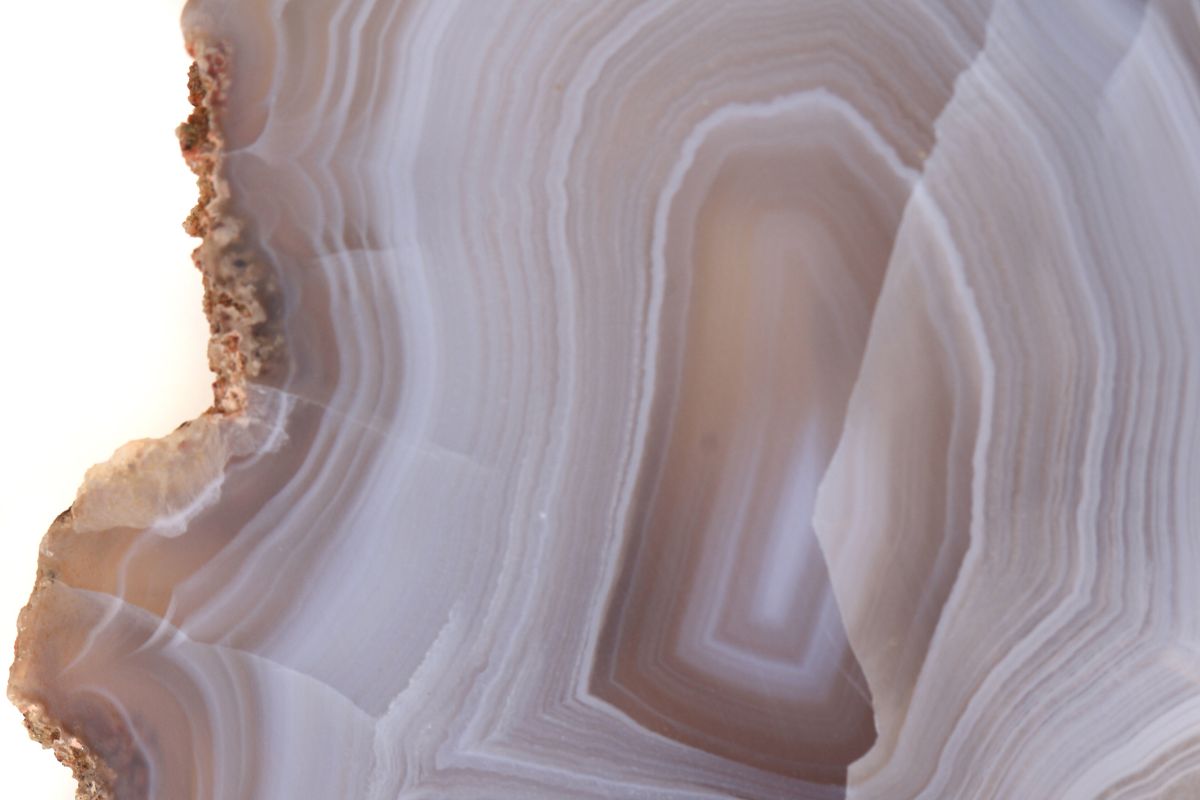
Montana Agate is a beautiful gemstone that showcases a combination of stunning colors and unique geological features. It also holds special meaning for those who believe in its healing properties and metaphysical significance.
By exploring its volcanic history, color variations, and physical and spiritual benefits, we can appreciate it as a tangible representation of our planet’s rich past.
From its birthplace in the alluvial deposits of the Yellowstone River to its designation as Montana’s state gemstone, Montana Agate is truly emblematic of the state’s natural bounty. As it adorns jewelry and decor, Montana Agate becomes both a personal style statement and a link to nature’s enduring elegance.
If you’re considering bringing a piece of Montana Agate into your collection, be it a strand of beads or a soothing worry stone, take heart in knowing that like you, every agate is unique and has a story to tell.
Just as it has unfolded its narrative to geologists, collectors, and the curious, it awaits your interpretation, your loving care, and your narrative. So, dive into Montana Agate’s palette of subtle hues and vivid patterns – there’s a little slice of Montana’s vibrant past waiting for you to discover.
Montana Agate FAQs
1. What Is Montana Agate Good For?
Montana Agate is prized for its aesthetic beauty and is commonly used in jewelry making, cabochons, and lapidary art, with its unique banding patterns and vibrant colors making it a sought-after material for creating one-of-a-kind pieces.
Additionally, some believe that agates, including Montana Agate, have metaphysical properties, such as promoting balance and stability.
2. How Do I Identify a Montana Agate?
To identify Montana Agate, you need to look for its unique patterns of bands that display a mix of opaque and translucent layers in different colors, including red, orange, yellow, and brown.
Its small to medium-sized nodules, along with moss-like inclusions or other distinctive formations, also help differentiate Montana Agate from other types of agate.
3. Where Does Montana Agate Come From?
Montana Agate stones are mainly discovered in the riverbeds and gravel bars of the Yellowstone River. These stones are particularly abundant near the towns of Livingston and Big Timber.
4. What Color Is Montana Agate?
Montana Agate displays a diverse spectrum of colors, which includes but is not restricted to shades of red, orange, yellow, brown, and white, coupled with intricate banding designs that add to its exclusive and lively look.
5. What Are Montana Agates Made Of?
Montana Agates are primarily composed of cryptocrystalline quartz, also known as chalcedony, with their distinctive colors and banding patterns attributed to the presence of various mineral impurities and inclusions, such as iron and manganese oxides.
Uncover more fascinating facts about Montana in the articles below:

